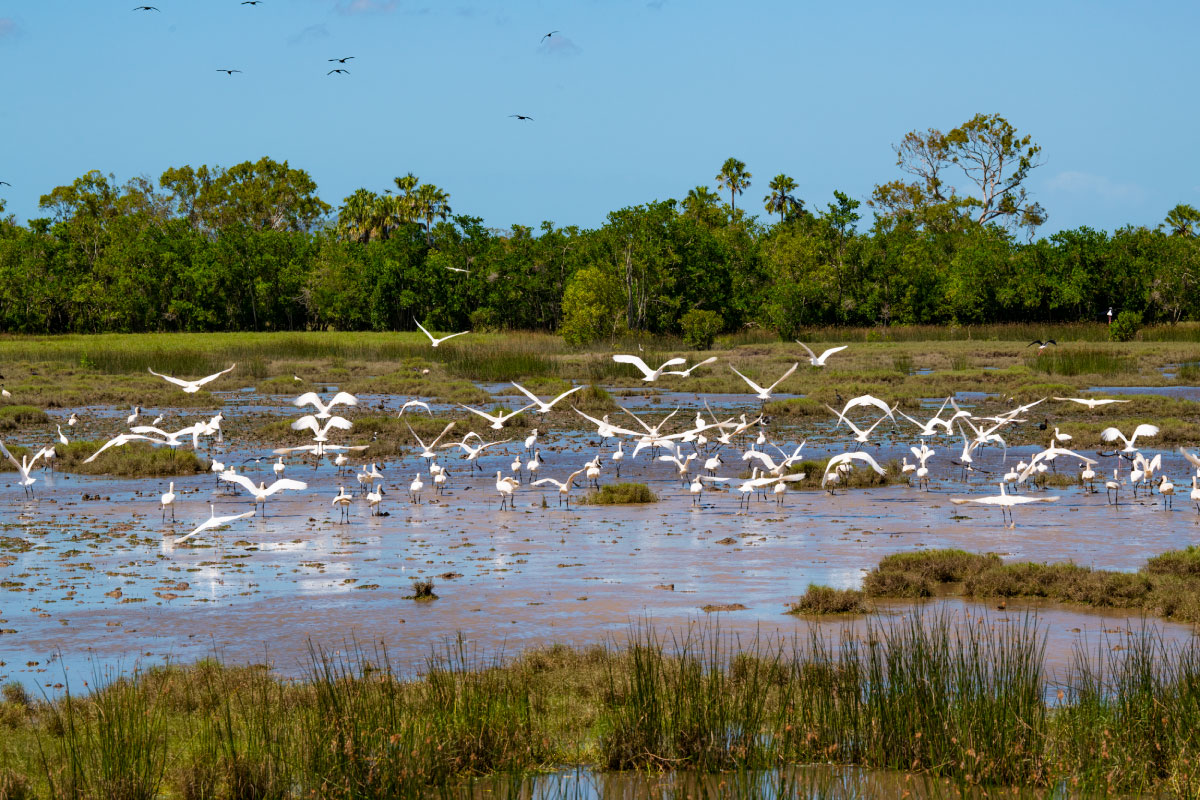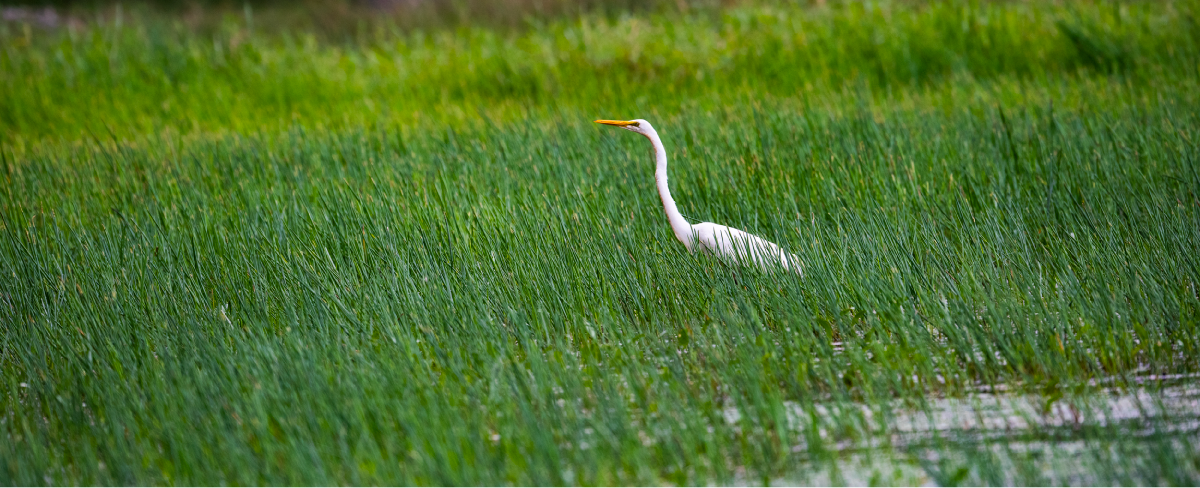|
|
Quick facts
- Directly working with the
- beneficiaries of ecosystem services will improve social acceptance of changes that rehabilitation activities may bring.

Ecosystem service assessments
A number of processes can be undertaken to identify the ecosystem services and values of a system – usually referred to as ecosystem service assessments (service assessments)[14]. These service assessments can be either quantitative (e.g. AquaBAMM for conservation assessments) or qualitative (e.g. Wetland Prioritisation Decision Support System (DSS) Great Barrier Reef Catchment) and should involve stakeholders and beneficiaries in their design. Service assessments can be quite complex and many are undertaken for individual services. The service assessments for a site scale should incorporate assessments of services and values which have been conducted at a broader scale (e.g. AquaBAMM for conservation assessments).
Site service assessments should address a clearly defined planning question[14] (set in Step 2 of the Rehabilitation Process and informed by Step 1) and be:
- specific to the site being rehabilitated, but incorporate broader landscape assessments
- conducted at the appropriate scale (both temporal and spatial)
- inclusive of the stakeholders and beneficiaries of the system
- guided by clear rehabilitation objectives
- informed by the best-available data and evidence.[15][14][6]
An ecosystem service assessment conducted as part of the Rehabilitation Process may follow these steps:
- understand the components, processes, and services provided at a system-scale (refer to Step 1)
- define the boundaries of the rehabilitation site and its connections to the broader landscape (e.g. the spatial area of the site being rehabilitated)
- identify the components and processes of the rehabilitation site, including the type of system
- undertake a condition assessment of the system to inform how services may be affected by the condition
- identify and engage the key stakeholders and beneficiaries of the rehabilitation project to assist with identifying the services (see beneficiaries and stakeholders below)
- select and document the highest priority services (approximately 5 or more depending on the site and stakeholder/ beneficiaries) which may be provided and how those services may be provided by the site
- categorise the values (biophysical, social, cultural and economic) that stakeholders and beneficiaries associate with the identified services
- document the desired changes to components and processes required to deliver the services that beneficiaries want as an outcome of the rehabilitation and any potential conflicts which may arise
- establish metrics for assessing and measuring changes in the services delivered as part of the rehabilitation[14][6].
It is important to record services in a manner that people can understand and relate to. However, the services recorded should then be classified and categorised in accordance with the modified CICES categories[6]. See What services do wetlands provide? for more information about categorising services.
Identifying current and potential services provided by an ecosystem
The current state and condition of the aquatic ecosystem, its connection with the surrounding landscape, and the existing services known to be important to beneficiaries at a distinct point of time, generally informs rehabilitation activities[13]. Current services provided by an ecosystem include those services that the system provides in its existing state. Ecosystem service assessments conducted using the Framework can help identify if the system is functioning as it should be and what services the system is (or is not) providing.
Potential services provided by a system include those services that may result from rehabilitation interventions and/or services that are not realised until a specific event (e.g. flood, fire) occurs that triggers or restores a process. For example, revegetating a wetland may improve the erosion control service provided by many wetlands[5] or increase the potential for carbon sequestration. After a flood event, groundwater, aquifers, or other water sources may be recharged, which allows for the provision of drinking water[16]. Modelling can be used to identify potential services that may be generated by rehabilitated components and processes and that are valued by the beneficiaries who may use them[13][15][4]. Identification of potential services should be conducted with stakeholders and beneficiaries to ensure that rehabilitation meets their specific needs[13][14][2] and understand if the services generated by a rehabilitated system will complement or be in conflict with one another[3].
Prioritising services for rehabilitation
Most aquatic ecosystems provide multiple services, so priority services should be identified in the Rehabilitation Plan to ensure that biophysical, social, cultural and economic outcomes are achieved through the project[18]. Beneficiaries and other stakeholders must be involved in any prioritisation process[18][1][9]. Many beneficiaries have strong social and cultural values that cannot be monetised and as such, are often omitted from decision-making[13][11][3]. Co-designing the prioritisation process with beneficiaries can identify any potential trade-offs that may arise from rehabilitating a system to provide specific services[18][1][9]. Involving beneficiaries and stakeholders in prioritising services ensures that the project remains objective and that the selected services reflect the true needs and values of the stakeholders.
Many rehabilitation projects use spatial prioritisation to identify high-value services (current and potential) and inform rehabilitation targets[9][15][18]. Where possible, prioritisation should avoid focusing on a single service and/or a single spatial scale and should instead focus on generating benefits at a whole-of-system scale to achieve “wise-use” outcomes.
For rehabilitation projects, a sub-set of high-value services should be identified (e.g. five or more if resources allow). Ensure that an accurate record of the prioritisation process is documented to inform monitoring and future management activities, including the list of services not considered “high-value”.
What constitutes a high-value service to a beneficiary can vary and is specific to the system being rehabilitated. For example, in highly impacted or degraded areas, such as urban landscapes, high-value services might include services such as shade provided by revegetated green spaces to cool down urban areas[12]or the human health and well-being benefits provided by blue spaces[8]. Other high-value services might include the provision of fisheries for fishing or tourism in areas where biodiversity rehabilitation is a target[17].
References
- ^ a b Bullock, JM, Aronson, J, Newton, AC, Pywell, RF & Rey-Benayas, JM (October 2011), 'Restoration of ecosystem services and biodiversity: conflicts and opportunities', Trends in Ecology & Evolution. [online], vol. 26, no. 10, pp. 541-549. Available at: https://linkinghub.elsevier.com/retrieve/pii/S0169534711001777 [Accessed 22 November 2021].
- ^ Carroll, C, Waters, D, Vardy, S, Silburn, DM, Attard, S, Thorburn, PJ, Davis, AM, Halpin, N, Schmidt, M, Wilson, B & Clark, A (2012), 'A Paddock to reef monitoring and modelling framework for the Great Barrier Reef: Paddock and catchment component', Marine pollution bulletin. [online], vol. 65, no. 4-9, pp. 136-149. Available at: Scopus.
- ^ a b Cebrián-Piqueras, MA, Karrasch, L & Kleyer, M (February 2017), 'Coupling stakeholder assessments of ecosystem services with biophysical ecosystem properties reveals importance of social contexts', Ecosystem Services. [online], vol. 23, pp. 108-115. Available at: https://linkinghub.elsevier.com/retrieve/pii/S2212041616301541 [Accessed 21 November 2021].
- ^ Department of Environment and Energy (2016), Wetlands and resilience to natural hazards. [online] Available at: https://www.environment.gov.au/water/wetlands/publications/factsheet-wetlands-resilience-natural-hazards.
- ^ a b Elliott, M, Burdon, D, Atkins, JP, Borja, A, Cormier, R, de Jonge, VN & Turner, RK (May 2017), '“And DPSIR begat DAPSI(W)R(M)!” - A unifying framework for marine environmental management', Marine Pollution Bulletin. [online], vol. 118, no. 1-2, pp. 27-40. Available at: https://linkinghub.elsevier.com/retrieve/pii/S0025326X17302692 [Accessed 21 June 2021].
- ^ a b c Everard, M & Waters, R (2013), Ecosystem services assessment: How to do one in practice (Version 1, October 13). [online], Institution of Environmental Sciences, London. Available at: https://www.the-ies.org/sites/default/files/reports/ecosystem_services.pdf.
- ^ Fu, B, Wang, S, Su, C & Forsius, M (March 2013), 'Linking ecosystem processes and ecosystem services', Current Opinion in Environmental Sustainability. [online], vol. 5, no. 1, pp. 4-10. Available at: https://linkinghub.elsevier.com/retrieve/pii/S1877343512001893 [Accessed 24 October 2021].
- ^ Gascon, M, Zijlema, W, Vert, C, White, MP & Nieuwenhuijsen, MJ (November 2017), 'Outdoor blue spaces, human health and well-being: A systematic review of quantitative studies', International Journal of Hygiene and Environmental Health. [online], vol. 220, no. 8, pp. 1207-1221. Available at: https://linkinghub.elsevier.com/retrieve/pii/S1438463917302699 [Accessed 23 November 2021].
- ^ a b c Gilvear, DJ, Spray, CJ & Casas-Mulet, R (September 2013), 'River rehabilitation for the delivery of multiple ecosystem services at the river network scale', Journal of Environmental Management. [online], vol. 126, pp. 30-43. Available at: https://linkinghub.elsevier.com/retrieve/pii/S0301479713001904 [Accessed 22 November 2021].
- ^ Kelble, CR, Loomis, DK, Lovelace, S, Nuttle, WK, Ortner, PB, Fletcher, P, Cook, GS, Lorenz, JJ & Boyer, JN (12 August 2013), 'The EBM-DPSER Conceptual Model: Integrating Ecosystem Services into the DPSIR Framework', PLoS ONE. [online], vol. 8, no. 8, p. e70766, ed. M G Chapman. Available at: https://dx.plos.org/10.1371/journal.pone.0070766 [Accessed 19 November 2021].
- ^ Klain, SC & Chan, KMA (October 2012), 'Navigating coastal values: Participatory mapping of ecosystem services for spatial planning', Ecological Economics. [online], vol. 82, pp. 104-113. Available at: https://linkinghub.elsevier.com/retrieve/pii/S0921800912002728 [Accessed 23 June 2021].
- ^ Loughner, CP, Allen, DJ, Zhang, DL, Pickering, KE, Dickerson, RR & Landry, L (October 2012), 'Roles of Urban Tree Canopy and Buildings in Urban Heat Island Effects: Parameterization and Preliminary Results', Journal of Applied Meteorology and Climatology. [online], vol. 51, no. 10, pp. 1775-1793. Available at: https://journals.ametsoc.org/view/journals/apme/51/10/jamc-d-11-0228.1.xml [Accessed 23 November 2021].
- ^ a b c d Malinga, R, Gordon, LJ, Lindborg, R & Jewitt, G (2013), 'Using Participatory Scenario Planning to Identify Ecosystem Services in Changing Landscapes', Ecology and Society. [online], vol. 18, no. 4, p. art10. Available at: http://www.ecologyandsociety.org/vol18/iss4/art10/ [Accessed 19 November 2021].
- ^ a b c d e Rosenthal, A, Verutes, G, McKenzie, E, Arkema, KK, Bhagabati, N, Bremer, LL, Olwero, N & Vogl, AL (3 July 2015), 'Process matters: a framework for conducting decision-relevant assessments of ecosystem services', International Journal of Biodiversity Science, Ecosystem Services & Management. [online], vol. 11, no. 3, pp. 190-204. Available at: https://www.tandfonline.com/doi/full/10.1080/21513732.2014.966149 [Accessed 21 November 2021].
- ^ a b c Schröter, M & Remme, RP (February 2016), 'Spatial prioritisation for conserving ecosystem services: comparing hotspots with heuristic optimisation', Landscape Ecology. [online], vol. 31, no. 2, pp. 431-450. Available at: http://link.springer.com/10.1007/s10980-015-0258-5 [Accessed 22 November 2021].
- ^ Talbot, CJ, Bennett, EM, Cassell, K, Hanes, DM, Minor, EC, Paerl, H, Raymond, PA, Vargas, R, Vidon, PG, Wollheim, W & Xenopoulos, MA (December 2018), 'The impact of flooding on aquatic ecosystem services', Biogeochemistry. [online], vol. 141, no. 3, pp. 439-461. Available at: http://link.springer.com/10.1007/s10533-018-0449-7 [Accessed 23 November 2021].
- ^ Townsend, M, Davies, K, Hanley, N, Hewitt, JE, Lundquist, CJ & Lohrer, AM (10 October 2018), 'The Challenge of Implementing the Marine Ecosystem Service Concept', Frontiers in Marine Science. [online], vol. 5, p. 359. Available at: https://www.frontiersin.org/article/10.3389/fmars.2018.00359/full [Accessed 22 November 2021].
- ^ a b c d Vaz, AS, Amorim, F, Pereira, P, Antunes, S, Rebelo, H & Oliveira, NG (November 2021), 'Integrating conservation targets and ecosystem services in landscape spatial planning from Portugal', Landscape and Urban Planning. [online], vol. 215, p. 104213. Available at: https://linkinghub.elsevier.com/retrieve/pii/S0169204621001766 [Accessed 22 November 2021].
Last updated: 30 June 2022
This page should be cited as:
Department of Environment, Science and Innovation, Queensland (2022) Identify existing and potential ecosystem services, WetlandInfo website, accessed 8 May 2025. Available at: https://wetlandinfo.des.qld.gov.au/wetlands/management/rehabilitation/rehab-process/step-2/services.html
|

 — Department of the Environment, Tourism, Science and Innovation
— Department of the Environment, Tourism, Science and Innovation



